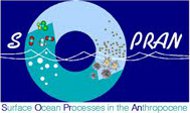SOPRAN: Production-decomposition dynamics of volatile halocarbons
Our research is embedded in the SOPRAN project (SOPRAN - Surface Ocean Processes in the Anthropocene).
SOPRAN is a multi-disciplinary project funded by the BMBF (Bundesministerium für Bildung und Forschung). Including a wide range of institutes and universities it is a german contribution to the international SOLAS programme. Aspects of atmosphere-ocean interaction are the focus of SOPRAN and special attention is drawn to changes in atmospheric and surface ocean processes, their relation to climate-related changes and, finally, how this affects ocean-atmosphere exchange processes.
More information about SOPRAN objectives, project partners and publications can be found here: http://sopran.pangaea.de/home.
Aim of our subproject is to understand the biological regulation of production, decomposition and atmospheric export of volatile halogenated organic compounds (VHOCs) in the marine environment. Changes in the equilibrium between biological production and degradation of VHOCs are studied by integrating aspects of marine chemistry, algal physiology, microbiology and molecular biology. Our analytical methods include MDGC-MS-IRMS to determine VHOCs concentration and isotopic composition (delta 13C) as well as molecular biological techniques including RNA-stable isotope probing to identify organisms and key enzymes involved in VHCOs turnover.
Initial work showed that the variability in VHOCs concentrations in the coastal Baltic Sea was mainly attributed to autotrophic biomass and seasonality (Orlikowska and Schulz-Bull, 2009). To further examine the impact of different light quantity and quality on VHOCs dynamics and mass balances and their underlying biological regulating factors, gastight surface mesocosms (see picture below) are employed which enclose the top of the water column and the atmosphere above, where e.g. light conditions can be experimentally modified. This in-situ approach is complemented by laboratory experiments using cultures of marine microalgae and bacteria to get insights into species-specific patterns of VHOCs production and degradation processes. Finally, cruises into the Baltic Sea during summer cyanobacterial blooms are undertaken, to better describe the processes involved in known cyanobacterial VHOCs production (Karlsson, et al., 2008).

